Abstract
1. Bovine nasal cartilage was extracted with inorganic salt solutions of various ionic strengths. The efficiency of extraction of protein–polysaccharide from the tissue was determined for each extraction. The results confirm and enlarge earlier observations (Sajdera & Hascall, 1969). 2. The chloride salts of lanthanide metals extract high yields of protein–polysaccharide from the tissue at much lower concentrations than was achieved with univalent and bivalent salts. 3. The lanthanum salt of extracted protein–polysaccharide precipitates when the concentration of LaCl3 is decreased. Precipitation is complete in the presence of 0.05m-LaCl3. This finding is relevant to the interpretation of earlier observations on the effect of LaCl3 on elastic recovery of articular cartilage after compression (Sokoloff, 1963). 4. A linear relationship was found between the concentration at which a particular salt is maximally effective in solubilizing protein–polysaccharide from the tissue and the enthalpy of hydration of the cation of the salt. On the basis of this relationship a hypothesis is proposed to explain the characteristic protein–polysaccharide-extraction profiles exhibited by inorganic salt solutions.
Full text
PDF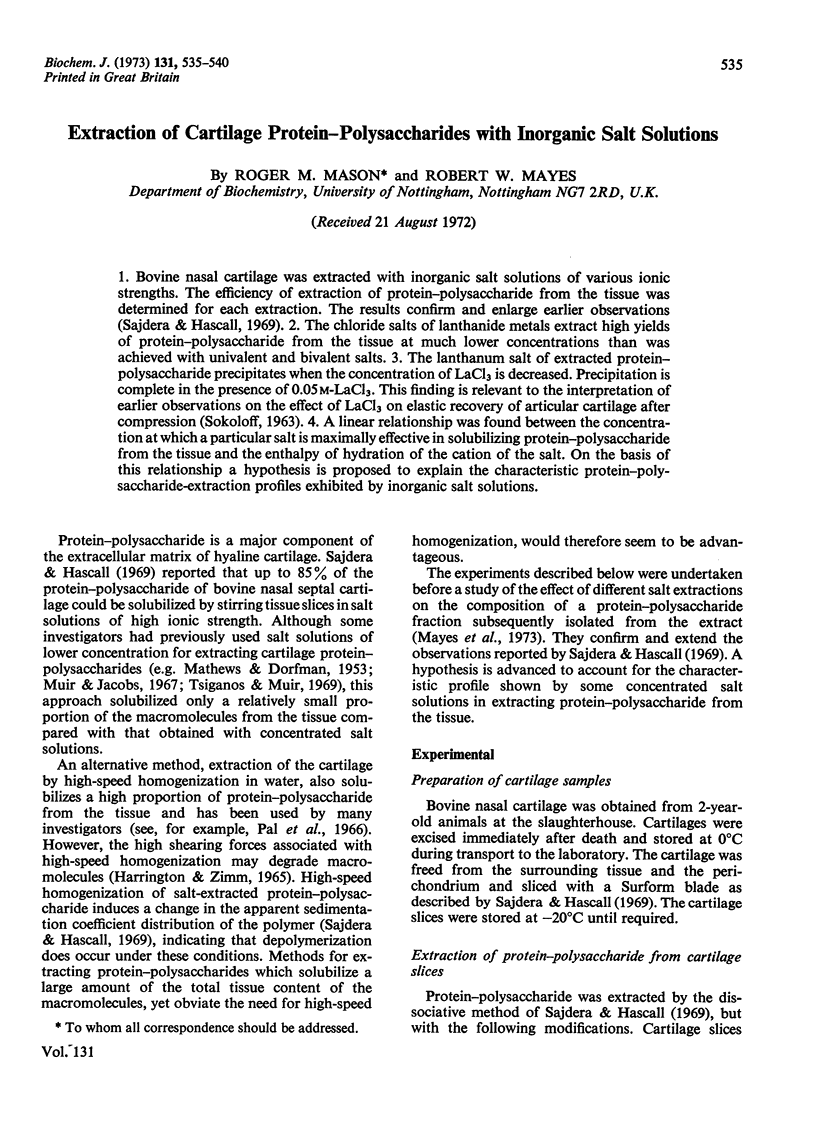
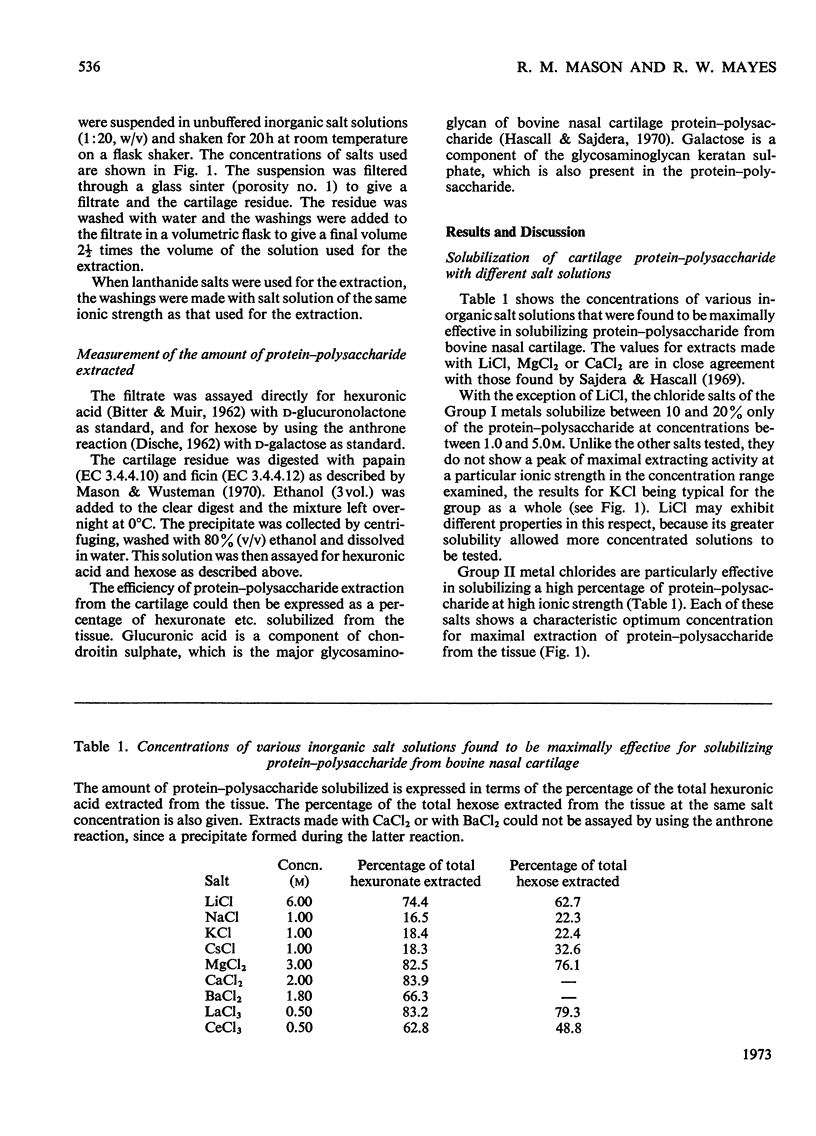
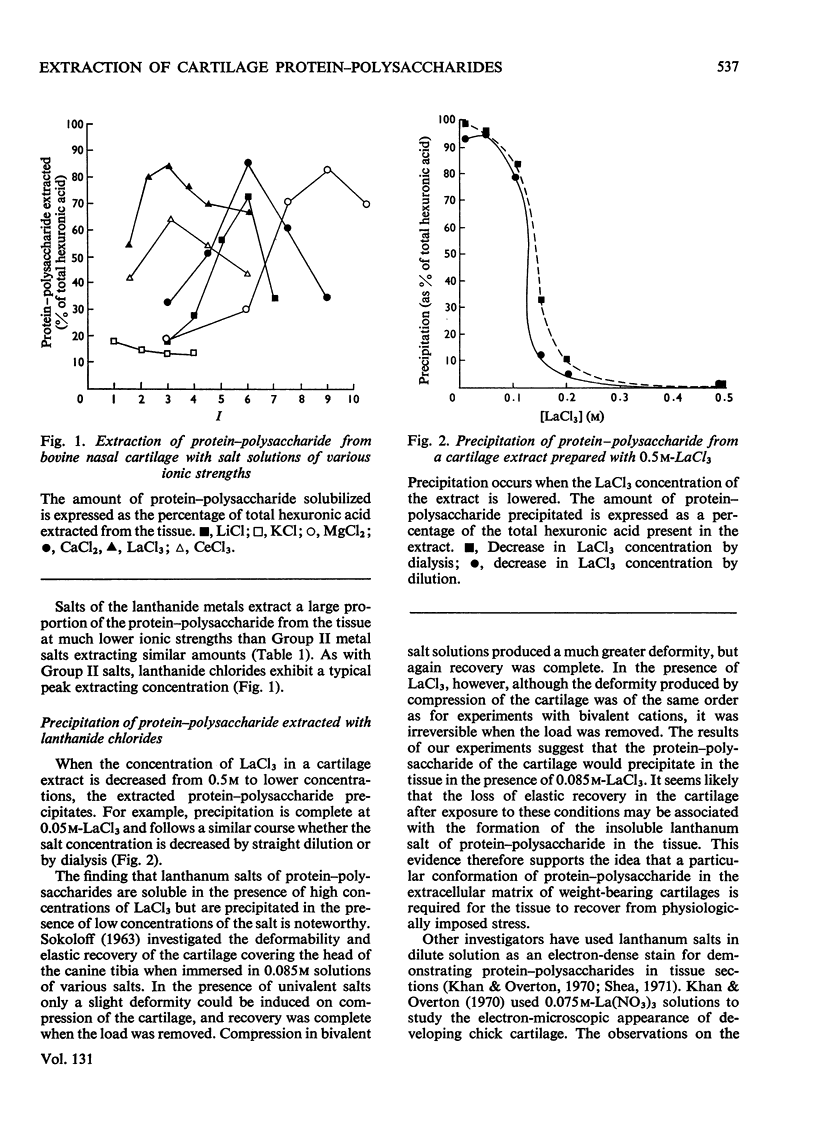
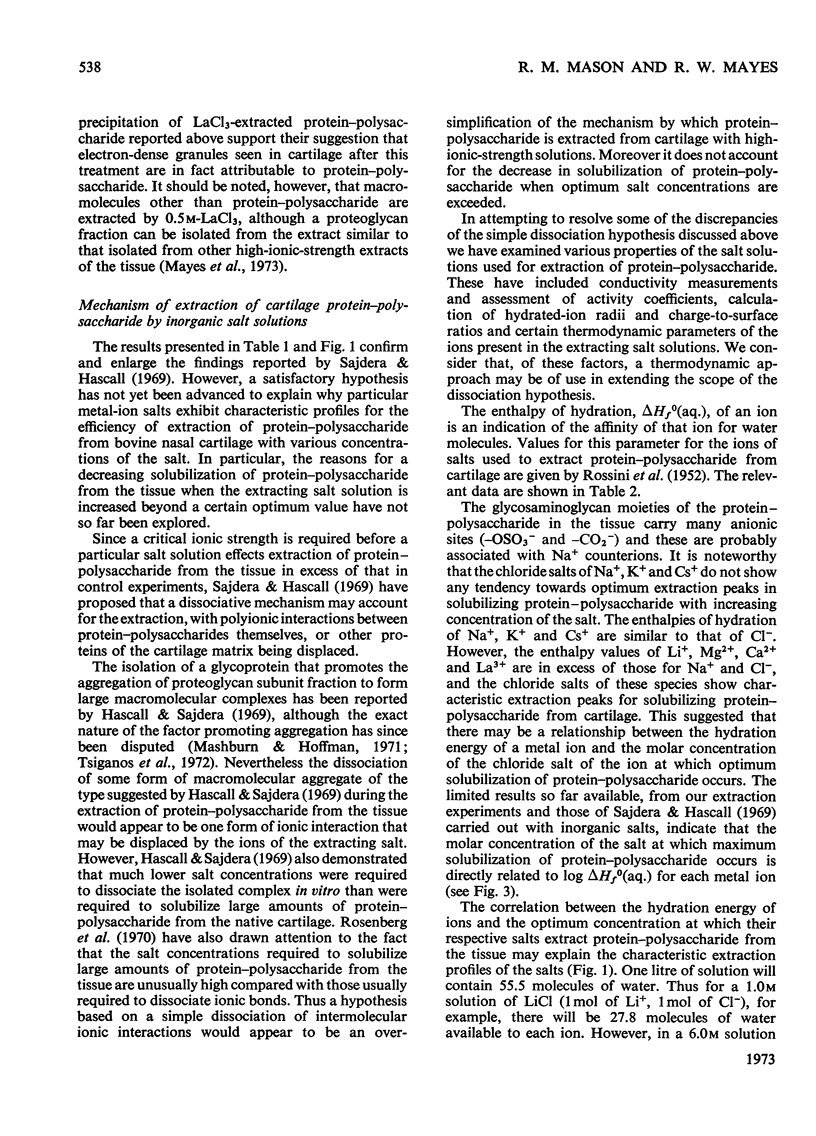
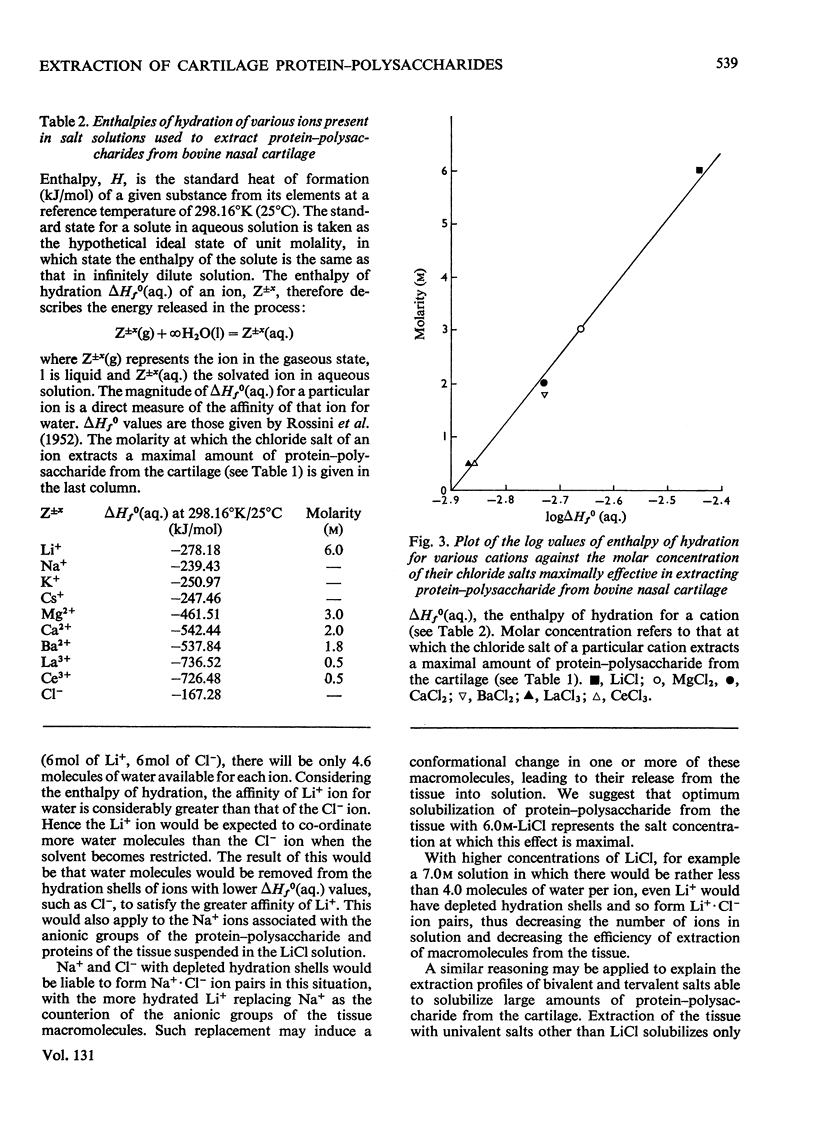
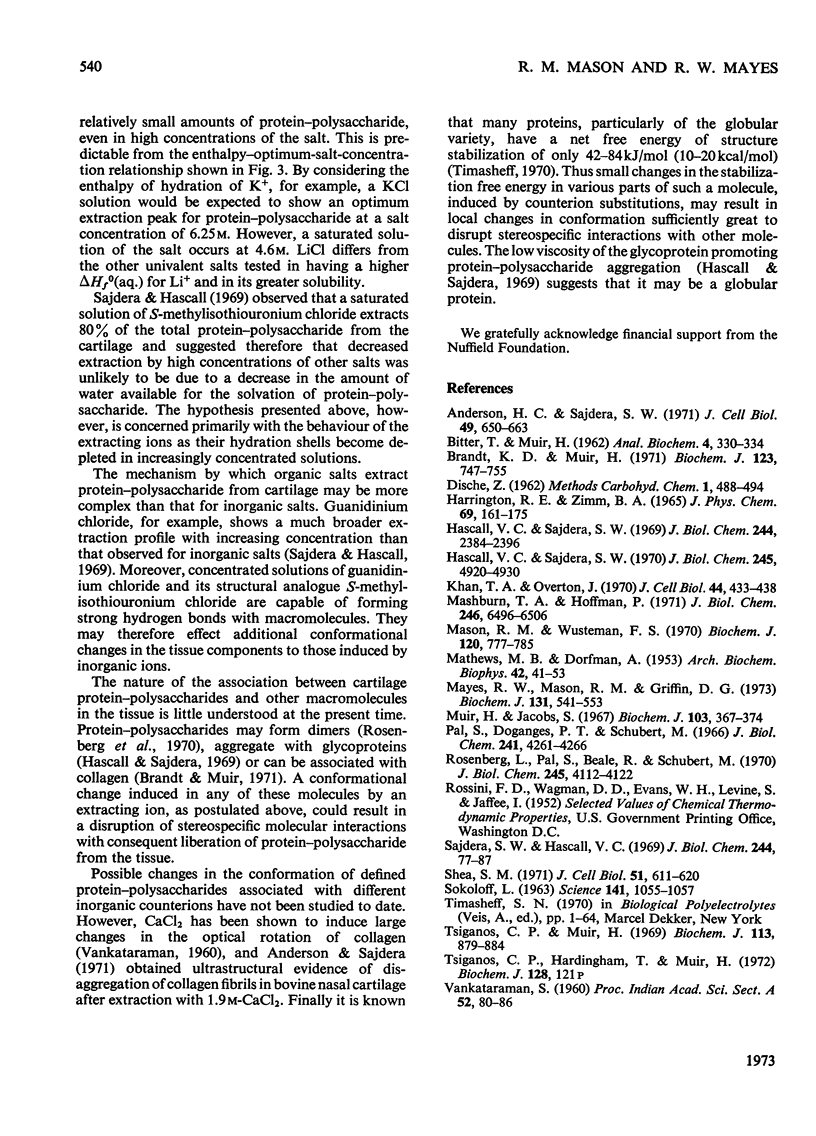
Selected References
These references are in PubMed. This may not be the complete list of references from this article.
- Anderson H. C., Sajdera S. W. The fine structure of bovine nasal cartilage. Extraction as a technique to study proteoglycans and collagen in cartilage matrix. J Cell Biol. 1971 Jun;49(3):650–663. doi: 10.1083/jcb.49.3.650. [DOI] [PMC free article] [PubMed] [Google Scholar]
- BITTER T., MUIR H. M. A modified uronic acid carbazole reaction. Anal Biochem. 1962 Oct;4:330–334. doi: 10.1016/0003-2697(62)90095-7. [DOI] [PubMed] [Google Scholar]
- Brandt K. D., Muir H. Heterogeneity of protein-polysaccharides of porcine articular cartilage. The chondroitin sulphate proteins associaterd with collagen. Biochem J. 1971 Aug;123(5):747–755. doi: 10.1042/bj1230747. [DOI] [PMC free article] [PubMed] [Google Scholar]
- Hascall V. C., Sajdera S. W. Physical properties and polydispersity of proteoglycan from bovine nasal cartilage. J Biol Chem. 1970 Oct 10;245(19):4920–4930. [PubMed] [Google Scholar]
- Hascall V. C., Sajdera S. W. Proteinpolysaccharide complex from bovine nasal cartilage. The function of glycoprotein in the formation of aggregates. J Biol Chem. 1969 May 10;244(9):2384–2396. [PubMed] [Google Scholar]
- Khan T. A., Overton J. Lanthanum staining of developing chick cartilage and reaggregating cartilage cells. J Cell Biol. 1970 Feb;44(2):433–438. doi: 10.1083/jcb.44.2.433. [DOI] [PMC free article] [PubMed] [Google Scholar]
- MATHEWS M. B., DORFMAN A. The molecular weight and viscosity of chondroitinsulfuric acid. Arch Biochem Biophys. 1953 Jan;42(1):41–53. doi: 10.1016/0003-9861(53)90235-5. [DOI] [PubMed] [Google Scholar]
- Mashburn T. A., Jr, Hoffman P. Comparative fractionation studies of cartilage proteinpolysaccharides. J Biol Chem. 1971 Nov;246(21):6497–6506. [PubMed] [Google Scholar]
- Mason R. M., Wusteman F. S. The glycosaminoglycans of human tracheobronchial cartilage. Biochem J. 1970 Dec;120(4):777–785. doi: 10.1042/bj1200777. [DOI] [PMC free article] [PubMed] [Google Scholar]
- Mayes R. W., Mason R. M., Griffin D. C. The composition of cartilage proteoglycans. An investigation using high- and low-inonic-strength extraction procedures. Biochem J. 1973 Mar;131(3):541–553. doi: 10.1042/bj1310541. [DOI] [PMC free article] [PubMed] [Google Scholar]
- Muir H., Jacobs S. Protein-polysaccharides of pig laryngeal cartilage. Biochem J. 1967 May;103(2):367–374. doi: 10.1042/bj1030367. [DOI] [PMC free article] [PubMed] [Google Scholar]
- Pal S., Doganges P. T., Schubert M. The separation of new forms of the proteinpolysaccharides of bovine nasal cartilage. J Biol Chem. 1966 Sep 25;241(18):4261–4266. [PubMed] [Google Scholar]
- Rosenberg L., Pal S., Beale R., Schubert M. A comparison of proteinpolysaccharides of bovine nasal cartilage isolated and fractionated by different methods. J Biol Chem. 1970 Aug 25;245(16):4112–4122. [PubMed] [Google Scholar]
- SOKOLOFF L. ELASTICITY OF ARTICULAR CARTILAGE: EFFECT OF IONS AND VISCOUS SOLUTIONS. Science. 1963 Sep 13;141(3585):1055–1057. doi: 10.1126/science.141.3585.1055. [DOI] [PubMed] [Google Scholar]
- Sajdera S. W., Hascall V. C. Proteinpolysaccharide complex from bovine nasal cartilage. A comparison of low and high shear extraction procedures. J Biol Chem. 1969 Jan 10;244(1):77–87. [PubMed] [Google Scholar]
- Shea S. M. Lanthanum staining of the surface coat of cells. Its enhancement by the use of fixatives containing Alcian blue or cetylpyridinium chloride. J Cell Biol. 1971 Dec;51(3):611–620. doi: 10.1083/jcb.51.3.611. [DOI] [PMC free article] [PubMed] [Google Scholar]
- Tsiganos C. P., Muir H. Studies on protein-polysaccharides from pig laryngeal cartilage. Extraction and purification. Biochem J. 1969 Aug;113(5):879–884. doi: 10.1042/bj1130879. [DOI] [PMC free article] [PubMed] [Google Scholar]


